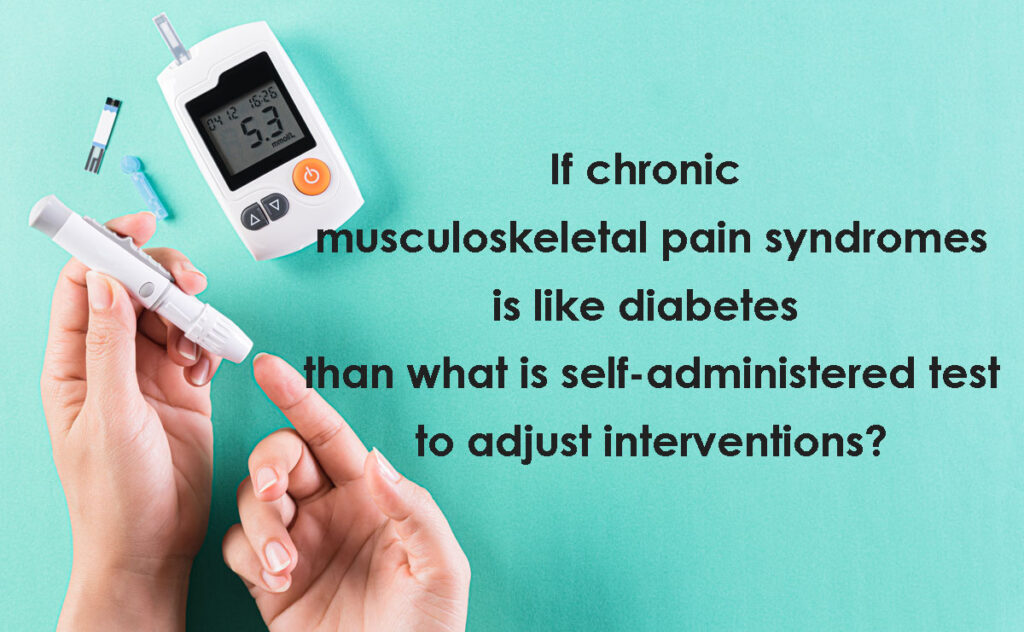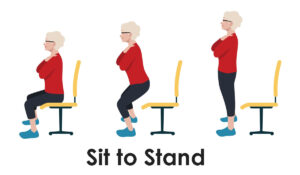Movement-evoked pain measurement for adjustment of interventions for chronic musculoskeletal pain syndromes

If chronic musculoskeletal pain syndrome is like diabetes, then what is a self-administered test to adjust interventions?
A thought-provoking article by Jermey Lewis and Peter O’Sullivan suggests “Is it time to reframe how we care for people with non-traumatic musculoskeletal pain” they suggest we have a lot to learn from how other chronic medical and health conditions are managed.
If non-traumatic musculoskeletal chronic pain syndromes are like diabetes then management should include the use of objective measures that the individual can self-administer to capture responses to interventions like measuring blood sugar to manage diabetes.
Testing the level of sugar in the blood, an individual with diabetes can adjust his/her medication and/or activity/exercise levels to maintain pain levels in an optimal range to better manage chronic musculoskeletal pain syndromes.
Currently, there is no consensus on what is a good objective measure that an individual can self-administer to capture his/her response to interventions for musculoskeletal pain syndrome.
Observing movement is an important variable to consider when managing chronic musculoskeletal pain syndromes. The assumption is there is a direct relationship between pain and movement. Pain affects movement. Movement affects pain. If pain occurs with movement, then observation and analysis of movement is compulsory.
The current practice is to measure pain intensity at rest, or from questionnaires asking to recall pain experienced during functional activities.

Movement-evoked pain measurement collects the symptomatic pain data simultaneously with activity or movement. This should enhance decisions regarding interventions.
Caroline Perraudin and colleagues provide an example using movement-evoked pain measurement for individuals with arthritis who experience symptoms of pain and stiffness every morning. They use a self-administered standardized task that may elicit movement-evoked pain and/or symptoms of stiffness, the “five times sit to stand test”.

The individual performs a standardized task of sit-to-stand in 5 seconds in their own homes. They collect subjective data regarding pain and stiffness. They use wearable sensors to document the objective results of the 5 times sit-to-stand performance test. The investigators did not describe how they used this information to adjust interventions.
How to use self-administered movement-evoked pain measurement to adjust interventions.
Subjective and objective data seen and felt during the standardized movement-evoked pain measure can be used to decide to:
- Keep interventions of medication, use of supportive devices, exercise, and/or activity level the same
- Progress/increase interventions medication, use of supportive devices, exercise, and/or activity
- Regress/decrease intervention medication exercise and/or activity.
Here are a few examples of standardized movement tasks that may elicit movement-evoked pain and/or other symptoms such as weakness, stiffness, or other symptoms:
Back pain
Lower Extremity
Static stance, half squat, heel raise test
Upper Extremity
Closed kinetic upper extremity stability test
Functional impairment test – Hand & neck/shoulder/arm Fit-Hansa
The above list can be a starting point to develop a personal individualized standardized movement task that may elicit movement-evoked pain and/or other symptoms such as weakness, stiffness, or other symptoms which can facilitate adjustment and self-management of chronic musculoskeletal pain.
The process should:
- Use movement, physical activity, and/or exercise.
- Be a valid and reliable measure.
- Be able for the individual to self-administer, easy to obtain, and analyze data.
- Provide information that can facilitate appropriate change in intervention.
Example:
I have rheumatoid arthritis with chronic hip pain. I chose the 6-minute walk test and modified it to serve as a movement-evoked pain measurement. Each day I take my dog for a morning walk which takes approximately 30 minutes. My dog likes to take the same route every day. Using the same route provides a standard and consistent physical challenge.
Despite the chronic hip pain that occurs with long walks It is a very enjoyable activity. It facilitates creative thoughts and organizes a plan for my day. Benjamin Smith and colleagues conclude pain during exercise for chronic musculoskeletal pain need not be a barrier to successful outcomes. Zero pain is not the goal.
This daily activity provides an opportunity for me to observe relevant data points including:
- Pain intensity relative to functional limitations (see table below)
- How long it takes for increased pain from walking to return to baseline zero rest pain?
- Level of perceived exertion
- Level of fatigue of hip muscles
- How long it takes to do the walk?
- How much do I need to depend on the use of a walking stick?
- Data from wearable devices (steps, heart rate, other information)
| Pain Intensity Level | Category | Pain evoked with movement |
| 0 | No Pain | Able to perform standard movement task |
| 1 to 3 | Mild Pain | Able to perform standard movement tasks but I experience pain |
| 4 to 6 | Moderate Pain | Able to perform some but not all the standard movement tasks due to pain |
| 7 to 9 | Severe Pain | Unable to perform most of my normal daily activities due to pain. Individuals with severe pain (7-9 range) would require partial assistance from another person to perform most normal daily activities including self-care. |
| 10 | Extreme Pain | Unable to perform any of my normal daily activities due to pain. Individuals with extreme pain (10) would require complete assistance from another person for all activities of daily living. |
By recording data in a diary it facilitates reflective learning. I am in the process of learning how to switch from a pen and paper diary to recording data digitally in a smartphone app. There are smartphone apps available to diary health information. There is availability to synchronize wearable data with narrative data on pain.
The table below illustrates how I use movement-evoked pain intensity and time to return pain to the baseline level of pain to alter and adjust self-management of my chronic hip pain.
| Movement-evoked pain measure & time to return to baseline level of pain | Action regarding intervention | Medication considerations |
| No joint soreness after the last session | Eligible to progress exercise/activity “Push & Build” | Consider a decrease in medication |
| Joint/tendon soreness after the last session gone by the next morning | Eligible to progress exercise/activity “Push & Build” | Keep medication same |
| Morning after soreness is 3 or < out of 10 or a mild level of soreness | Stay with the same amount of exercise/activity “On the Fence” | Keep medication same |
| Joint/tendon sore for 24 hours after last session | Regress the amount of exercise/activity “Rest & Protect” | Keep medication |
| Joint/tendon sore for more than one day after last session | Regress the amount of exercise/activity “Rest & Protect” | Consider an increase in medication |
| Morning after soreness is > 3 out of 10, or a moderate level of soreness | Regress the amount of exercise/activity “Rest & Protect” | Consider an increase in medication |
I can share the information gathered from my standardized movement-evoked pain task with my healthcare provider for assistance on how to best adjust my medication.
The medication for my rheumatoid arthritis requires a combination of medicines including oral prednisone. Prednisone has many side effects. The goal is to use the lowest possible dose for the shortest possible time. Standard practice is to gradually wean off prednisone based on self-reported subjective information. The weaning or tapering process can be enhanced by using objective data from standardized individualized movement evoked pain measurement data.
A standardized individualized movement-evoked pain measurement can be used to provide direction for altering interventions for chronic musculoskeletal pain syndromes, like testing blood sugar levels to manage diabetes. The process above is not fully optimized. I am eager to hear criticism and suggestions on how such a process can be improved.
The information on this website is not intended or implied to be a substitute for professional medical advice, diagnosis, or treatment. You are encouraged to perform additional research regarding any information contained available through this website with other sources and consult with your physician.
Damien Howell Physical Therapy – 804-647-9499 – Fax: 866-879-8591 At-Home, At Office, At Fitness Facility – I come to you, I do home visits Damien@damienhowellpt.com
